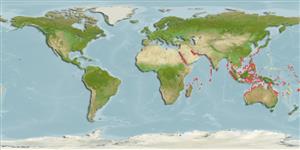>
Gobiiformes (Gobies) >
Gobiidae (Gobies) > Gobiinae
Etymology: Pleurosicya: Greek, pleura = side, ribe + Greek, sikya, -as = cucumber (Ref. 45335).
Environment: milieu / climate zone / depth range / distribution range
Ecologia
marino demersale; distribuzione batimetrica 3 - 15 m (Ref. 90102). Tropical
Indo-West Pacific: Red Sea, Egypt and Israel, Thailand and Australia.
Size / Peso / Age
Maturity: Lm ? range ? - ? cm
Max length : 1.7 cm TL maschio/sesso non determinato; (Ref. 83991)
Spine dorsali (totale): 6 - 7; Raggi dorsali molli (totale): 8-9; Spine anali 1; Raggi anali molli: 8 - 9. Characterized by semi-transparent; iris red; head and body with numerous pepper-like melanopores, concentrated on side below dorsal fins; longitudinal scale series 15-27; mostly scaleless head and anterior third of body; restricted gill opening to pectoral fin base; extremely elongated tip of upper jaw and lip, looks like curved beak; depth of body at anus 4.2-7.1 in SL (Ref. 90102).
Commensal with large staghorn corals in 3-15 m (Ref 90102).
Life cycle and mating behavior
Maturità | Riproduzione | Deposizione | Uova | Fecundity | Larve
Goren, M. and M. Dor, 1994. An updated checklist of the fishes of the Red Sea (CLOFRES II). The Israel Academy of Sciences and Humanities, Jerusalem, Israel. 120 p. (Ref. 12541)
IUCN Red List Status (Ref. 130435)
Threat to humans
Harmless
Human uses
Informazioni ulteriori
Nomi ComuniSinonimiMetabolismoPredatoriEcotossicologiaRiproduzioneMaturitàDeposizioneSpawning aggregationFecundityUovaEgg development
Age/SizeAccrescimentoLength-weightLength-lengthLength-frequenciesMorfometriaMorfologiaLarveDinamica popolazioni larvaliReclutamentoAbbondanzaBRUVS
BibliografiaAcquacolturaProfilo di acquacolturaVarietàGeneticaElectrophoresesEreditarietàMalattieElaborazioneNutrientsMass conversion
CollaboratoriImmaginiStamps, Coins Misc.SuoniCiguateraVelocitàModalità di nuotoArea branchialeOtolithsCervelliVista
Strumenti
Special reports
Download XML
Fonti Internet
Estimates based on models
Preferred temperature (Ref.
123201): 25 - 29.3, mean 28.5 °C (based on 2442 cells).
Phylogenetic diversity index (Ref.
82804): PD
50 = 0.5000 [Uniqueness, from 0.5 = low to 2.0 = high].
Bayesian length-weight: a=0.00708 (0.00333 - 0.01504), b=3.09 (2.92 - 3.26), in cm total length, based on LWR estimates for this (Sub)family-body shape (Ref.
93245).
Trophic level (Ref.
69278): 3.0 ±0.3 se; based on size and trophs of closest relatives
Resilienza (Ref.
120179): Alto, tempo minimo di raddoppiamento della popolazione meno di 15 mesi (Preliminary K or Fecundity.).
Fishing Vulnerability (Ref.
59153): Low vulnerability (10 of 100).
